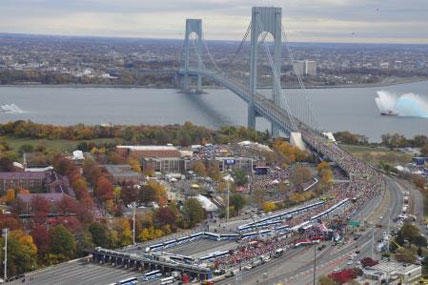NEW YORK - Dedication, sweat, preparation and heart. Runners in the New York City Marathon may be the most visible part of this event, but they are merely the tip of the iceberg when you look at who is involved in organizing and keeping the public safe in one of the world's largest and most competitive road races.
Coast Guard Sector New York shares a unique history with the New York City Marathon in that the race pre-stages its runners at Fort Wadsworth, which is co-located with the Sector in Staten Island. For 17 years, the Coast Guard has been behind the scenes, working to produce a functioning event and ensuring that every aspect of the start of the race runs smoothly for the athletes, spectators, and volunteers.
Due to the implications of the starting location, the Verrazano Narrows Bridge, along with the logistical impacts associated with such a large crowd and a short-term surge of activity, it is a security surge operation for the Coast Guard Sector. It is, indeed, a Herculean task.
"What's amazing is it's a one day event," said Mike Di Trani, Coast Guard Sector New York's Command Security Officer. "The planning started six, seven months ago. If you could imagine taking everybody in the Coast Guard; active duty, reserve, civilian and auxiliary, and ordering them all here to Fort Wadsworth, that's about 50,000 people. That's how many people we're having here for breakfast."
The marathon brings approximately $250 million in economic impact to the city, making it the highest-grossing, single-day sporting event in New York. It draws more than 124,000 applicants, two million spectators and 2,000 volunteers. 185 charities were represented by more than 6,500 runners and the marathon alone raised more than $26.2 million for charitable causes.
After the Boston Marathon bombing earlier this year, the Coast Guard coordinated with various law enforcement agencies to ensure the safety of everybody involved in making the race successful. Coast Guard Police, Coast Guard Canine Units, Coast Guard Auxiliarists, U.S. Park Police, NYPD Explosive Detection Canines and handlers were all involved in conducting sweeps of the race area prior to the beginning of the marathon and continued inspecting all persons, vehicles and packages entering Fort Wadsworth. No spectators were allowed inside the fort and anybody working in or around the marathon had to have a credential, which is a badge with photo identification, a hologram and an area-specific label.
New rules to mitigate potential threats were set in place for the marathon. Runners were not allowed to carry backpacks or hydration bags and restrictions were enforced on the types of costumes participants were allowed to wear.
"The Coast Guard has a huge part in this," said Di Trani. "It's the biggest land-based security operation in the Coast Guard."
Security is not the only aspect of the race that the Coast Guard had to take into account to ensure the event ran smoothly. Assets from the sector were relocated to Bayonne and other parts of New Jersey in order for them to remain active in their duties, since Fort Wadsworth was completely shut down to civilians as well as active duty Coast Guard personnel.
The Coast Guard's main concern during the event was for the safety of the public, government personnel and property, and preventing terrorist activity. A triage center was organized on the fort and crowds were controlled through the use of fences, barriers, bib information, color coding and numbers. Language barriers were also taken into account because many runners are from various countries. Television screens and announcement systems were all in different languages and the color of a runner's bib matched the color of the chute they had to report to at the start of the race.
The organization and safety plans put in place prior to the race allowed the Coast Guard to be proactive and prepared to ensure a successful start to the New York City Marathon. The safe and secure race was a much needed win for the City of New York following the cancellation of the race one year earlier due to the massive devastation from Super Storm Sandy.




























